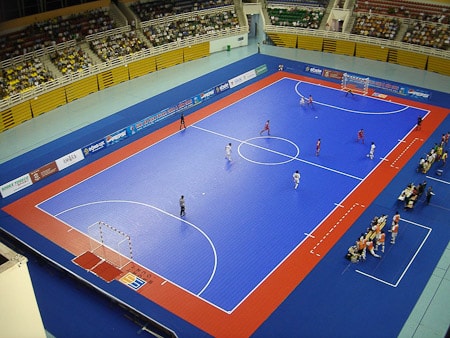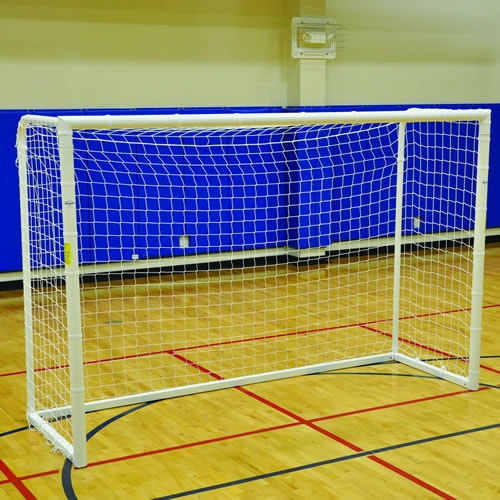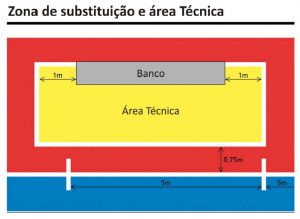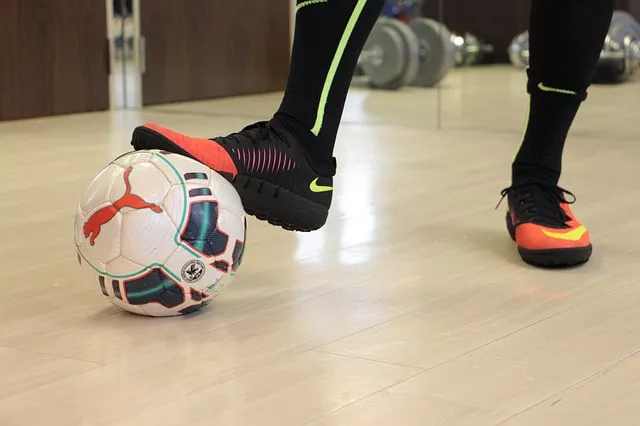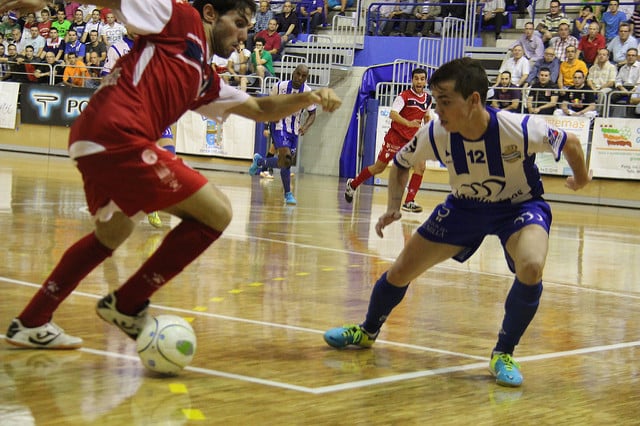Introduction: Futsal Rules and Fundamentals
In Futsal Rules and Fundamentals the DEF prepared for you a well illustrated content focusing on the main rules of Futsal and the main fundamentals of Futsal.
⇒ The Futsal Rules
01) What are the Futsal court dimensions?
The Futsal court is a rectangle and its dimensions are as follows:
- FIFA international competitions: 38 to 42 meters long and 20 to 25 meters wide.
- Adult National competitions (Brazil) and under-20: minimum of 38 meters in length and a minimum of 18 meters in width.
- Women’s Adult National competitions, U-20, U-17 and U-15 and Men’s National competitions U-17 and U-15 the minimum length is 36 meters and the minimum width is 18 meters.
02) What size are the Futsal goal posts?
The size of goal posts are 3 meters wide between the posts, and the height of the crossbar is 2 meters from the ground.
03) Futsal Substitutions and Substitution Zone
Futsal substitutions are unlimited during the match. However, there is an area where the substitution will take place in Futsal, which is located in front of each bench / technical area, with 5 meters wide.
04) A Futsal Team is formed by how many players?
A Futsal team consists of 5 players, and one of them is the goalkeeper. In official competitions, the maximum number of substitute players is 9. Substitutions in Futsal are unlimited. Substitutions may occur while the ball is in play or out of play, if they occur in the SUBSTITUTION ZONE.
05) What is the duration of a Futsal match?
A Futsal game is timed and divided into two equal periods. For adult, u-20 and u-17 matches, there will be two 20-minute periods, whereas for u-15 matches, it will consist of two 15-minute periods. The half- time interval must not exceed 15 minutes.
06) Futsal Goalkeeper Fouls
In Futsal, the goalkeeper is not allowed to possess the ball for over 4 seconds, with his feet or hands, in his defense zone. On the attack zone, the goalkeeper can touch the ball freely and for as long as he wants as an outfield player.
It is allowed only one pass-back to the goalkeeper; the goalkeeper may not receive a pass-back using his hands. After a pass-back, the goalkeeper may only receive the ball in his defense zone if an opponent touches it.
07) Red Card / Sending-off in Futsal:
- The team that has a player sent off, will remain with one less player for 2 minutes or until suffering a goal.
- If both teams have players sent off and have the same number of players in court, the teams will only be reset after 2 minutes.
- If both teams have players sent off, but one of the teams is numerically inferior because they have had more players sent off, the team in numerical inferiority can have the return of a player after suffering a goal. Ex.: Team A had two players sent off, team B had 1 player sent off; if team A, who is in numerical inferiority, concedes a goal in less than 2 minutes after the sending off, team A could have a player returned.
08) Kick-in in Futsal
The kick-in in Futsal is taken with feet, the ball must be placed on the touchline or outside but not more than 25cm away from the court; the player who takes the kick-in cannot have their feet inside the field of play. The kick-in must be taken within 4 seconds. It is not allowed to score directly from a kick-in.
09) Goal clearance in Futsal
Goal clearance in Futsal must be exclusively taken by the goalkeeper, by using their hands, and it must leave the penalty area within 4 seconds.
10) The Corner Kick in Futsal
The corner kick in Futsal must be taken with feet within 4 seconds and the ball must be placed in the corner area.
⇒ The Technical Fundamentals of Futsal
What are Futsal Skills?
Futsal Skills are the techniques used during a Futsal match. Pass, kick and head are examples of Futsal Skills.
Which are the Futsal Skills?
Here are some futsal skills: ball trapping / reception, ball control, ball carrying, the pass, the kick, the head, the dribble and the feint. Please find below a summary of the main Futsal skills.
Ball Control Skill on Futsal
Ball Control in Futsal differs from the ball trapping because it refers to the act of keeping the ball under control without letting it fall to the ground. This skill is also popularly known as kick-ups.
Ball Reception / Trapping Skill
It is the act of receiving the ball in the Futsal. The trapping can be performed with any part of the body eligible by the Futsal Rules, such as feet, thigh, chest, head, among other parts. The main and most indicated technique for receiving / trapping the ball in Futsal is the “stepping”, which is when the Futsal player dominates the ball by stepping on it with the sole of the foot.
Ball Carrying Skill on Futsal
Ball Carrying is the act of carrying the ball on your possession through the pitch. It is possible to carry the ball in a straight line or changing direction (zigzag). Carrying can be performed by using the front of the foot, the instep or by stepping on the ball, the so-called “roll”. It is very important that the Carrying is performed with the ball always very close to the player’s feet.
Ball Pass Skill on Futsal
The ball Pass on Futsal is the act of sending the ball to a teammate. The Pass can be performed with any part of the body eligible by the Futsal Rules, such as the feet, thigh, chest, head, heel. The most used passing skill is performed by touching the ball with the inside of the foot, the so-called pass lead.
Kick or shooting skill on Futsal
The Kick on Futsal is the act of sending the ball towards the goal / goal of the opposing team with the intention of scoring a goal. The Kick can be performed with any part of the body allowed by the Rules of the Futsal; kick with the inside of the foot (lead), with the instep, back heel, thigh, and head. The best Kick is the one that unites precision and strength.
Head Skill on Futsal
It is the act of heading the ball. Heading in Futsal can be used defensively, to stop an opponent’s attack, to pass or in the form of a Kick / Finish, in order to score a goal. The most used Head Skill on Futsal is performed by using the forehead area.
Dribble Skill on Futsal
Dribbling on Futsal involves two other skills: Trapping and Carrying. Dribbling is the act of passing through a defender by trapping and carrying the ball. Dribbling requires change of direction, creativity, speed and agility, with the intention of deceiving the opponent and passing through it.
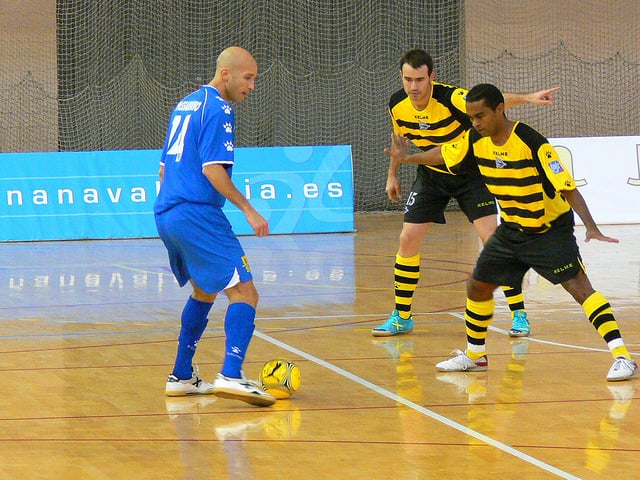
Body Dribbling in Futsal
The Body Dribbing in Futsal is different from the Dribble because it is performed without trapping the ball, and it is also known as Body Dribble / Body Feint. The Body dribbling is a creative skill, with a change of direction, not using the ball, performed in order to deceive the opponent, aiming to reach or receive the ball.
